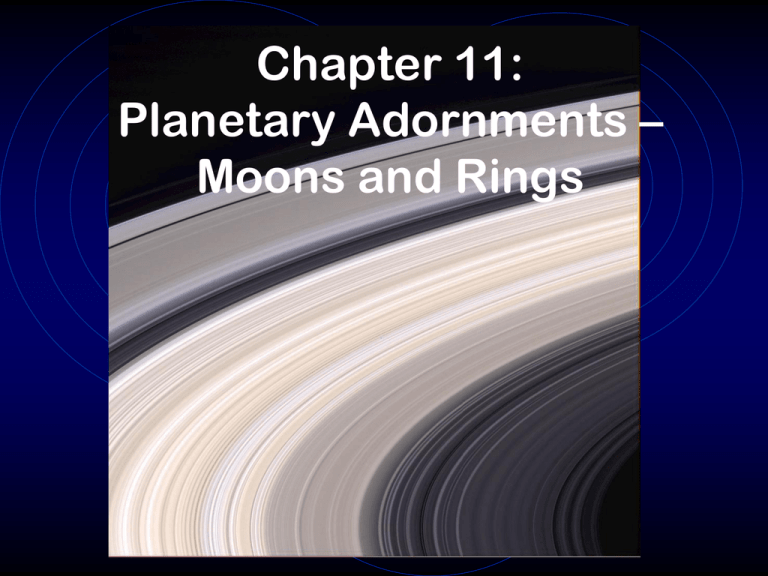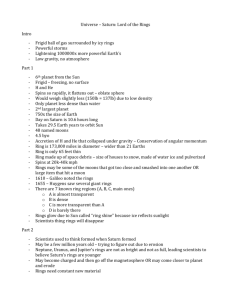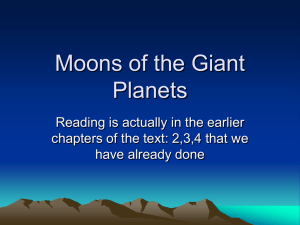Chapter 11: Planetary Adornments – Moons and Rings
advertisement

Chapter 11: Planetary Adornments – Moons and Rings Except for Mercury and Venus, all the planets have Moons The largest moon, Ganymede, has evolved since forming The moons of the outer planets are either geologically active, probably active or dead Geologically Active Moons Io is the innermost of the Galilean Moons and is thus rocky Io is the most volcanically active body in the solar system Many of Io’s volcanoes are actually sulfur geysers Lava flows on Io are of extremely hot magma (ultramafic) Temperatures of 1450° to 1750°C…400° to 500° hotter than Earth Enceladus is a mid-size moon of Saturn Enceladus has ice geysers It is warmer at the poles than at the equator! The cryovolcanism is from the “tiger stripes” Triton is the largest moon of Neptune Triton’s orbit is retrograde, at a high tilt angle but perfectly circular and in synchronous rotation. Nereid is a small moon that orbits in a regular way Triton has a thin atmosphere The atmosphere is mostly nitrogen Nitrogen Geysers on Triton There are areas on Triton that look like frozen lakes Transition region on Triton The transition is from the polar region with active geysers to a “cantaloupe” region of irregular hilly terrain Moons that are probably active Europa is the 2nd Galilean moon of Jupiter Europa has a frozen surface over a liquid ocean Ice Rafts of Europa Titan, the other “probably active” moon, is the largest moon of Saturn Titan has a thick atmosphere of nitrogen with a hydrocarbon haze which obscures the surface The haze is similar in chemical composition to smog. Think of LA on a really bad day and multiply by 100. Cassini’s IR & UV cameras penetrate Titan’s atmosphere Cassini has found a “sea” near the north pole of Titan The liquid is a mixture of ethane and methane The Huygens Probe descended to Titan’s surface Moons that were once active Ganymede is the largest moon in the solar system Transition Area Many areas of Ganymede look like features on Europa that froze long ago. There may still be liquid in Ganymede but it is deep in the mantle. Palimpsests form when impacts occur over a slushy sub layer Dione: a world of giant cliffs Tethys has huge ice cliffs, too Iapetus is a dark walnut Miranda, a moon of Uranus, has been broken and re-assembled Ariel is another Uranian moon The stillborn worlds: geologically dead since birth Callisto is the second largest moon of Jupiter Valhalla is a multi-ring impact structure on Callisto Mimas orbits Saturn The large impact basin is named Herschel Reality is stranger than fiction. George Lucas dreamed up the Death Star 3 years before the first images of Mimas from the Voyager mission Rhea: Ancient and cratered Hyperion is spongy Umbriel is a Uranian moon Oberon Proteus is another moon of Neptune Saturn’s rings were first observed by Galileo Galilei “I discovered another very strange wonder, which I should like to make known to their Highnesses . . . , keeping it secret, however, until the time when my work is published . . . . the star of Saturn is not a single star, but is a composite of three, which almost touch each other, never change or move relative to each other, and are arranged in a row along the zodiac, the middle one being three times larger than the lateral ones, and they are situated in this form: oOo.” Galileo Galilei July 30, 1610 Galileo’s Saturn Drawings Galileo observed Saturn for over two decades but never understood what the rings were With a better telescope, Christiaan Huygens figured it out and published his theory in 1659 In 1859 James Clark Maxwell published a theory on the nature of the rings that said they are not solid but composed of small objects in orbit around the planet A Saturnian Season by HST When the rings are edge on they are almost invisible All the giant planets have rings The major rings are all inside the Roche limit of their host planet. Most require special equipment and conditions to detect. Only Saturn’s rings are easily visible with a modest telescope. Saturn’s rings consist of thousands of ringlets The rings are composed of chunks of ice and rock While mostly ice, there is also a lot of dust and rock Shepherd Moons Prometheus and Pandora Pan and Encke Division Ring Spokes Jupiter’s rings were first observed by the Voyagers Jupiter’s rings were extensively studied by the Galileo probe Metis, Adrastea. Amalthea and Thebe are all small moons. The largest, Almathea, is about 100 km across. The rings of Uranus were discovered by occultation At last count, Uranus has 13 rings Neptune’s rings are clumpy



